|
Percussion, Wind and Stringed Introduction Music played a very important part in the highly developed social and cultural country of Ancient Egypt. In Egypt instruments were usually identified with the primary deities such as Hathor, Isis and Sekhmet and these deities would often be shown playing musical instruments such as the sistrum, drum and menit. Whether out in the street, in the temple, the palace or tombs music was part of many events, whether for religious, celebratory or pure entertainment purposes. It’s believed that rhythmic music was used in most Egyptian religious practices such as liturgy, rituals and processions and the pictorial evidence shows that many musicians were women. During the new Kingdom these females were highly trained and employed by large temples as priestesses and were known by the name "sem'ayt. Usually they were the wives or daughters of the priests and began to hold such titles as, "Song-stress of Amun". These women became quite powerful in their own right, holding high positions close to Pharaoh with the highest musician bearing the title "Chief of the Singers of Pharaoh". All of the temple hierarchy were devoted to solemn hymns and prayers, most of which were accompanied by music and often preformed to create a spell (a heka), or afford protection. Men on the other hand are often shown more in a military context, such as drummers or trumpeters. The most common instruments in use were the sistrum, round and rectangular frame drums, cymbals, crotals, wooden clappers and menits. The two main gods of ‘music and dancing’ were Hathor (female) and Bes (male). All music was called ‘Hy’ which meant joy or gladness, whilst the name for sound was "herw", meaning voice.  The sistrums, thought to have evolved from the archaic ritual of cutting papyrus stems and rattling them together rhythmically to ‘open one's heart to Hathor’, was held in the hand and shaken to made a sound not unlike that of a tambourine. The word sistrum means to sway to and fro, to vibrate. Made of wood, metal or ceramic it had a handle that branched out into a Y shape. Here bands of metal were fixed between the two stems and smaller pieces of metal attached so they jingled when the sistrums were shaken. Sistrums were particularly used in rituals relating to the Egyptian gods and goddesses and were often accompanied by chanting. The sistrum was the main instrument employed by the Egyptian priestess. 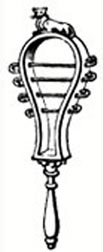 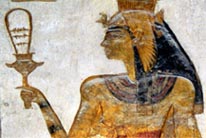 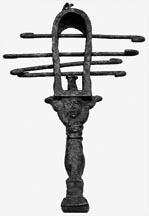 Cymbals, not dissimilar to our modern version in design, they were usually used in combination with drums and sistrums and would have sounded more like small hand bells. Unlike the vast majority of non-tuned modern cymbals, ancient ones were tuned to a specific musical note. They were not struck full against each other, but by one of their edges. Different sized cymbals would produce different notes and sound effects. Crotals made of wood or ivory, were clappers with two small cymbals attached to the end and were used widely in military, spiritual and religious events. (A variation on cymbals.) The Menit was a ceremonial object associated with the goddess Hathor and her priestesses would generally be shown holding the ‘Menit necklase’, which comprised of a number of beads strands gathered into a counterpoint. It’s believed that the menit was used as a kind of percussion instrument in certain ceremonies and accompanied the dances that were performed to heal, restore equilibrium and please the senses. The sound would have been not unlike that of a rattle. Discovered in the tomb of Tutankhamun, we see a scene where his wife is holding a sistrum and menit before Pharaoh. Also during the festival of Hathor the priestesses would go from door to door shaking the instrument in order to bring long life, health, and rebirth to the occupants. 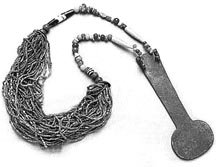 Drums: Harp: The harp, one of the oldest musical instruments, can be seen depicted on wall painting in Ancient Egyptian tombs that date back to 3000 BC. There are thought to have been developed from the ancient hunting bow. Lute:The lute has strings stretched along a neck attached to a resonating body. Again they have been found in Egyptian art, appearing in the archaeological New Kingdom period of the 18th Dynasty (1540-1307 BC). It is generally believed that the lute may have been introduced into Egypt. Classed as long necked lutes, the ancient Egyptian instruments generally had 2/3 strings (probably made of thin leather), a long stick neck and a drum-like body covered with animal skin. The neck was round, with or without frets. A small handful have survived. Trumpets: The first metal trumpets are attributed to the Egyptians, The Ancient Egyptian name for the trumpet was, sheneb. Eighteenth Dynasty artists drew them in tombs as short straight instruments made of wood or metal. These types of trumpets were mainly used for military signalling such as to direct and manage troops, encourage engagement and intimidate the enemy. Egyptian trumpeters are often shown in pairs and were the domain of men. The oldest surviving examples of metallic trumpets are the two instruments that were excavated during the discovery of the tomb of Tutankhamun in 1922 by Howard Carter. One, made of silver, was found wrapped in a reed cover and left in the southeast corner of the Burial Chamber outside the outermost golden shrine, it measures 58.2csm long, whilst the other, made of copper is 50.5 cm and was found in a long chest in the Antechamber. Both have wooden stoppers inserted within the bell end, probably to help protect the shape when not being played. Both are also inscribed with the most powerful Egyptian gods, Ra-Harakhty, Amun-Ra, and Ptah and the King himself. The mouthpieces are a cylindrical sleeve with a ring at the outer end and fixed to the outside of the tube; they are not cup-shaped or detachable. Vibrating the lips onto the fixed amplifying mouthpiece would have created the sound, which has been described as raucous and powerful, rhythmic and of single pitch. In 1939 famous recordings were made of both the silver and copper trumpets by the BBC played by a military bandsman, James Tappern of the 11th Prince Albert’s own Hussers. Unfortunately the use of a modern mouthpiece that was inserted into the silver trumpet and the force required to play shattered the three thousand year old instrument. Fortunately the trumpet was repaired to such a high standard by the firm Lucas that it would be played again in the Cairo Museum by another renowned trumpeter, Philip Jones. He reported that the sound was not melodious as the bore in relationship to the length of the trumpet was not proportional, but that it was probably the most thrilling experience he had ever had as a trumpet player. The trumpets have no valves and the lowest notes that could be clearly sounded were D and C respectively. It was common for instruments in antiquity to be of a single pitch and it had only been the use of the modern mouthpiece by James Tappern that had enabled a wider range of notes. A third trumpet thought to date from the Ptolemaic period, is held in the Louvre Museum in Paris, France. 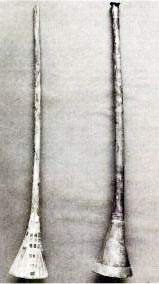
 This was the first time they had been played in over 3000 years |
|